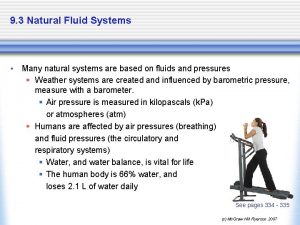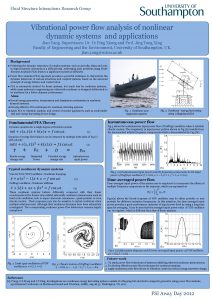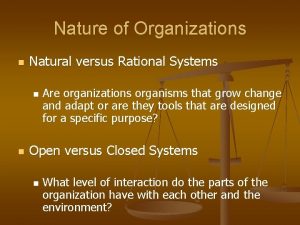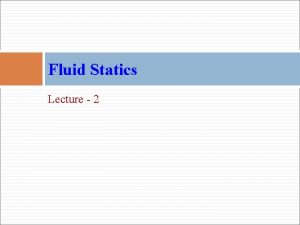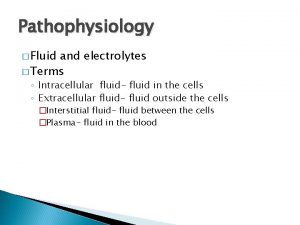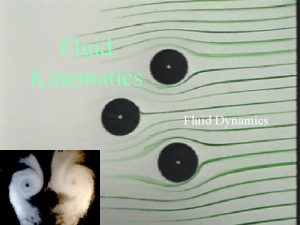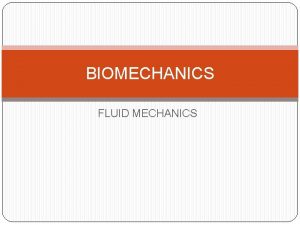9 3 Natural Fluid Systems Fluid Systems in

















- Slides: 17

9. 3 – Natural Fluid Systems

Fluid Systems in Humans Our body is an example of a fluid system. Our bodies are about 66% water! Water is important for our bodies because: • • • It helps us absorb food Transport nutrients Remove wastes Protect our tissues Helps maintain proper blood pressure – Too much or too little can affect blood circulation

The Circulatory System The circulatory system transports blood around the body. • Blood vessels are like the pipes. – Carry blood to all parts of the body. • The heart is like a pump. – The beating of the heart keeps the blood moving.

Blood Pressure Think of your circulatory system like a balloon filled with water. When you squeeze on it, the pressure is applied through the water in all directions.

Blood Pressure (con’t) • When your heart pumps blood through the circulatory system, pressure moves the blood. • Blood pressure is the force of the blood on the walls of the blood vessels. • Blood pressure can be measured using a sphygmomanometer.

Reading Blood Pressure Your doctor says: “Your blood pressure is 120/80” But what does that mean? ? • The first number (systolic) is the pressure from your blood being pushed out of the heart. • The second number (diastolic) is the pressure that occurs when your heart relaxes and refills with blood.


Disorders of Blood Circulation Blood pressure is an indicator of general health. The heart must work harder when blood pressure is high.

The Respiratory System The respiratory system is the set of organs and pathways involved in breathing. REMEMBER: gases move from HIGH to LOW pressure areas.

The Respiratory System (con’t) When you INHALE: • Your rib muscles move the rib cage up and out. • The diaphragm move downward After inhaling, the pressure on the outside of your body is the same as the inside of your lungs

Disorders of Breathing Bacteria, viruses and other micro-organisms can cause infections, such as colds, pneumonia, or bronchitis. These can cause swelling within the respiratory system, making it difficult to breathe.

Disorders of Breathing Asthma is a disease of the respiratory system that interferes with the normal flow of air into the lungs. • Attacks can be triggered by cold air, dust, exercise, and stress • Inhalers are used to deliver medication to the lungs

9. 3 - Review 1. Explain why the human circulatory system can be thought of as a natural hydraulic system. 2. Explain why the human circulatory system can be thought of as a natural pneumatic system. 3. Explain how the motion of your diaphragm causes you to inhale.

9. 3 - Review Angioplasty is a procedure where doctors insert a tiny balloon into a patient’s narrow, blocked artery on the outside of the heart, then expand the balloon. This forces the artery into a more open position. Why do you think doctors would use such a procedure?

9. 3 - Review Cardiopulmonary resuscitation (CPR) is an emergency procedure used to keep a person alive after his/her heart has stopped. One of the movements of CPR involves repeatedly pressing on the person’s chest. How do you think applying pressure to someone’s chest helps the person survive the heart stoppage?

9. 3 – Review Think-Pair-Share After lying down, many people feel a momentary feeling of dizziness if they stand up too quickly. Dizziness can be caused by a lack of blood to the brain. Explain why this temporary dizziness occurs. • You must include the words “pressure” and “pump” in your explanation.

9. 3 – Review Think-Pair-Share Feelings of nervousness or excitement can cause hiccups. Hiccups occur when your diaphragm becomes irritated and pushes upward in a very quick jerky motion. a. How might this jerk upward of the diaphragm affect the pressure in the lungs? b. How does this movement of the diaphragm affect your breathing?
 Natural fluid systems
Natural fluid systems Synovial fluid
Synovial fluid Fluid statics deals with fluid at rest
Fluid statics deals with fluid at rest Fluid statics deals with fluid at rest
Fluid statics deals with fluid at rest Transcellular fluid compartment
Transcellular fluid compartment Bioimpedância
Bioimpedância Hypoosmotic
Hypoosmotic Fluid kinematics example
Fluid kinematics example Extracellular fluid and interstitial fluid
Extracellular fluid and interstitial fluid Horseshoe dullness in ascites
Horseshoe dullness in ascites Natural hazards vs natural disasters
Natural hazards vs natural disasters Natural capital and natural income
Natural capital and natural income Advanced fluid systems
Advanced fluid systems Powerflow fluid systems
Powerflow fluid systems Natural system organization example
Natural system organization example Decision support systems and intelligent systems
Decision support systems and intelligent systems Principles of complex systems for systems engineering
Principles of complex systems for systems engineering Embedded systems vs cyber physical systems
Embedded systems vs cyber physical systems
